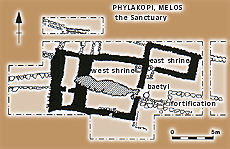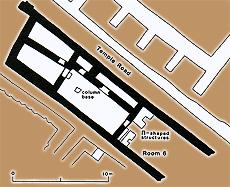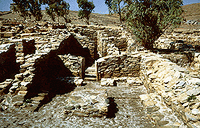We do not have information on the function of organized sanctuaries from the insular settlements of the Early Bronze Age. From the Middle Bronze Age the first cult elements in an independent and specially designed building appear. At the settlement of Agia Irini on Keos a sanctuary -the first sanctuary in the Aegean- was built in this period. It corresponds to the shape and function of the later sanctuaries of Mycenaean Greece. The Late Cycladic period provides more evidence on the cult in sacred buildings. The best researched sanctuaries of the islands are: the sanctuary of Agia Irini which continued to function incessantly from the Middle Bronze Age and the somewhat later sanctuary of Phylakopi on Melos. An indication for the definition of a building as a sanctuary is the particular architectural type and the finding of ritual objects and clay figurines in it. The architectural type of the insular sanctuaries has a tripartite plan, as those of mainland Greece. The sacred buildings are composed of an antechamber, a main room and two side chambers at the back. The various cult equipment (hearths and tripod tables of offerings) were placed in the centre of the main rooms. In the background was a bench on which the wooden statues of the deity, clay figurines and other votives were placed. Specifically, the wooden statues were placed on stone platforms, higher than the worshipers. As indicated in the sanctuaries of Phylakopi and Mycenae, the side chambers functioned as storerooms of the ritual ware. Despite the fact that the sacred character of the rooms is not clear and that the cult customs correspond mostly to Minoan ones Akrotiri on Thera also offers indications that sacred buildings were constructed with particular care. In contradiction to the mudbrick buildings of Akrotiri those that have been characterized sacred, the so-called Xeste, had a well-built stone masonry. As those of the mainland, the insular sanctuaries reveal many differences from the sacred buildings of Minoan Crete. This indicates a differentiation in the cult customs of these two cultures. The Mycenaean sanctuaries were freestanding buildings and not annexes to buildings of various functions, as in the case of the Minoan palaces. Moreover, there is no archaeological evidence on peak sanctuaries or sacred caves in the islands despite the fact that Mycenaean iconography and texts written on tablets imply the cult in sanctuaries of open spaces. The Mycenaean insular sanctuaries may have been a constant attraction of worshipers for a great period of time. As attested in the Mycenaean sanctuary of Apollo Maleatas at Epidauros, cult in rooms of the Mycenaean sanctuaries could have been associated with the archaic times. This version is supported by the discovery of Mycenaean ritual and particularly valuable objects under the Artemision of Delos. |
 |
|
|
Melos, Phylakopi. Plan of the Mycenaean sanctuary.
|
||
 |
||
|
Keos, Agia Irini.
Plan of the Late Bronze Age sanctuary. |
||

|
||
|
Keos, Agia Irini. View of the sanctuary.
|
||